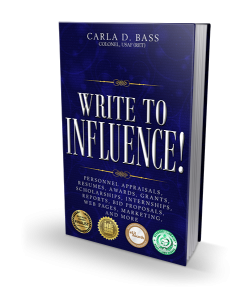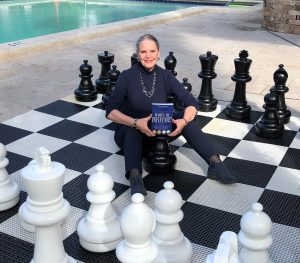 Congratulations! You now have a solid draft, following the writing strategies from my book Write to Influence! presented in my previous blog post, Write to Influence!, Part 1. Now what?
Congratulations! You now have a solid draft, following the writing strategies from my book Write to Influence! presented in my previous blog post, Write to Influence!, Part 1. Now what?
Sculpt it! Imagine a master sculptor facing an eight-foot tall piece of marble. He expertly wields his tools; a magnificent statue results. Your initial draft is akin to that chunk of marble. Using the ten Word Sculpting Tools below, you hone and refine . . . chipping away and discarding unnecessary words, writing with precision, and avoiding bureaucratic blather. Your result, equivalent to the sculptor’s statue, will be a clear, concise, and compelling product.
Write to Influence! Challenge
Let me demonstrate with a “Write to Influence!” challenge. Applying the Word Sculpting Tools, can you reduce this text from forty-eight to twenty words and improve its punch in the process? The answer concludes this blog . . . no fair peeking! This is based on a passage by a well-known author and is intended for an adult reader:
“He went through every detail of the plan in his head, both the shot he had to make and his safe exit that would hopefully follow. He had already memorized everything. but he wanted to arrive at the point where he no longer had to think, just act.” [48 words/246 characters]

Word Sculpting Tools
- Useless Words: Find, Chisel, Discard – Most critical of my ten Word Sculpting Tools. Goal – eliminate unnecessary words. Gained space affords the opportunity to further make your case.
Example: At this time, we request completion of the survey by next week. My POC for this effort is John Smith. Also, please address any questions to him at js@thisemail address. [Many useless words absent from the improved version. Please complete the survey by next week. Direct any questions to my POC, John Smith, at john.smith@thisaddress.]
- Shorter is Better: Don’t Hog Space – Most precise of the Word Sculpting Tools. Use when space is limited. Three aspects:
- Select shortest words.
- Use precise terms (i.e., one word in lieu of two or more).
- Write in the active voice.
Example: numerous = many; on a daily basis = daily; for the purpose of = to; as soon as possible = expeditiously
- Redundancy: Once Will Suffice – I characterize four types of redundancy:
- Words inferred in the text
- Unnecessary repetition
- Information so obvious, it should not be stated
- Double-tap subjects or verbs.
Example: They met to discuss how to eliminate redundancies that surreptitiously sneak into your writing. [Met and discuss are double-tap verbs, the first being a lesser, precursory action that leads to the second verb, central to the message. Surreptitiously and sneak are also redundant.]
- Lead with the Basics: Horse before the Cart – Lengthy, cumbersome, ancillary text often characterized by messy, ineffective writing that confuses the message and irritates the reader and is akin to wading thru knee-deep mud characterizes this writing technique.
Example: The sentence you just read, purposefully and horribly written to demonstrate this tool. Begin with the main thought, then follow with supporting data. More effectively written: This writing techniques is characterized by . . .
- Verbs are Your Friends: Rely on Them – Many authors use several words in lieu of a single verb to convey action, preferring bland bureaucratic text to clean, direct verbs.
Example: The committee members came to an agreement about the terms for the sale. [The committee agreed to the terms for the sale. Delete members as a useless word.]
- Avoid Gibberish: It’s Confusing – Several writing flaws constitute gibberish:
- Excessive detail
- Job-related jargon
- Inappropriate/incorrect use of acronyms
- Statistics that inadvertently generate questions
Example: She scored a +3/-3 on the Chinese DLPT. [Let me translate: Defense Language Proficiency Test; the score is reading/listening; +3 is the highest possible score. Significance, this young lady scored above 95 percent of her peers in the military test for proficiency in Chinese.]
- Tethers: In Sentences and Otherwise – A common sentence construction involves tethering several items to a base term. The author must ensure each item is correctly stated when associated with its base.
Example: The writer must identify, test, and validate tethers in a sentence. Identify, test, and validate are the items and tethers is the base. So, let’s check. Identify . . . tethers, test . . . tethers, and validate . . . tethers. Yep, these work.
- Be Clear: Who-Does-What-to-Whom? The writer dodges the pitfall of confusing writing by avoiding passive voice, misplaced phrases, useless words, nouns used as verbs, and other flaws of writing addressed thus far. The mantra to keep the story straight? Verify “Who-Does-What-to-Whom?”
- Keep the Focus: Shut the Gates! Every author is a tour guide, leading the reader from the opening word to the text’s conclusion, ideally without losing the reader along the way. The writer can inadvertently allow the reader to wander, distracted by poor writing techniques, failure to proofread, or terms that unintentionally prompt questions.
- Proof Carefully: Credibility’s at Stake – I intentionally place this tool last. Why? Emphasis. The author will lose both credibility and the reader’s attention if the product is rife with errors, regardless of how brilliantly written (using the aforementioned tools) or how relevant, thought provoking, and intellectually valuable the document might be.
Answer to the “Write to Influence!” Challenge
“He mentally reviewed every detail of the plan, especially the shot and his exit. His actions had to be instinctive.” [20 words/115 spaces]
For additional articles and information about my workshops, visit me at www.writetoinfluence.net.
 Carla D. Bass, Colonel, USAF (Ret), award-winning author and speaker, served thirty years in the Air Force and is renowned for her writing. She developed her writing methodology and taught thousands of Air Force members for fifteen years—to rave reviews. Based on her highly acclaimed book, Write to Influence!, she now teaches audiences ranging from professionals in the workplace to high school students.
Carla D. Bass, Colonel, USAF (Ret), award-winning author and speaker, served thirty years in the Air Force and is renowned for her writing. She developed her writing methodology and taught thousands of Air Force members for fifteen years—to rave reviews. Based on her highly acclaimed book, Write to Influence!, she now teaches audiences ranging from professionals in the workplace to high school students.
Leave a Reply